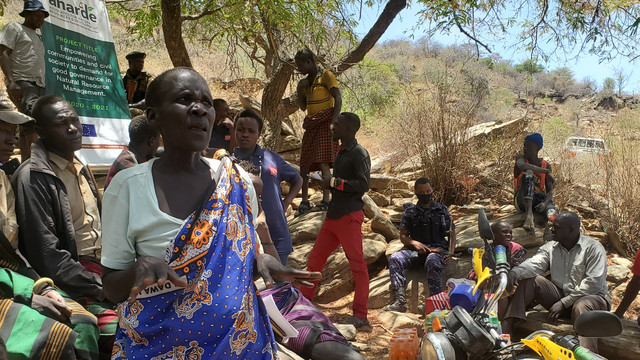Botswana: Biodiversity and dragons come together
With International Day for Biological Diversity on 22 May, a new biodiversity project highlights the importance of diversity and draws out tensions that arise when trying to put biodiversity at the centre of development policies.


Hippos bask in the sun in Botswana. A new project aims to encourage leaders to bring biodiversity into all levels of government planning to influence a new generation of biodiversity plans. Photo: MAZZALIARMADI.IT
“Are you asking me to be a charitable organisation, or are you asking me to invest?” asked James, a workshop participant and ‘dragon’ responding to a high-pressure pitch for investment, in the style of the well-known TV programme Dragons’ Den’.
Dineo Gaborekwe, from the Botswana Ministry of Environment, Wildlife and Tourism, was asking five ‘dragons’ or potential investors to financially support community projects to develop natural pharmaceutical and beauty products – already a proven success in Botswana.
The Dragons Den was part of a workshop recently held in Botswana bringing together representatives from different African countries to share ideas on how to integrate biodiversity into development policies.
The dragons’ expressions were tough and unforgiving; they gave nothing away, but then at the end, the questions started coming. “How much money do you want and what’s the return on investment?” from Jonathan. “I’m the minister of agriculture, why should I want more elephants when I’m dealing with the damage they cause?” asked Brian. And so it went on.
Never assume that putting biodiversity at the centre of development is going to be easy.
Making the business case for biodiversity
The business pitch had stressed the short and long-term benefits of ‘mainstreaming’ biodiversity including:
- new jobs
- stronger, more sustainable livelihoods
- more diverse products and
- potential advantages for the tourism industry.
The underlying message of the Botswana business pitch was simple: local people – whole countries in fact – can’t afford to let their biodiversity be lost. Livelihoods depend on it and ways must be found to incorporate conservation of biodiversity into policies across government – from agriculture, tourism and mining policies, financial strategies and budgeting.
Policy tensions
While this approach makes total sense, inevitably it gives rise to tensions. We heard earlier at the workshop that Uganda has discovered oil and gas in one of the world’s greatest biodiversity hotspots. What does a government do?
The Ugandan finance ministry quite rightly sees a chance for the economy to grow – but balancing short and long-term strategies is a major challenge. Seven and half million people still live in poverty and rely on the biodiverse richness of the country’s environment for their livelihoods. Extracting gas and oil means new roads, refineries, lorries and exclusion from this land.
It’s a real challenge, but we were told by a Ugandan project participant that economists, finance officials, conservationists and local communities are all talking together to find a resolution.
National Biodiversity Strategy and Action Plans
The four countries represented at the workshop – Uganda, Botswana, Namibia and the Seychelles – are the focus countries for a three–year project: NBSAPs 2.0 Mainstreaming Biodiversity and Development, which IIED is implementing with the United Nations Environment Programme – World Conservation Monitoring Centre (UNEP-WCMC).
These four countries, and 189 others, are party to the Convention on Biological Diversity and are in the throes of revising their National Biodiversity Strategy and Action Plans (hence the name of the project, NBSAPs 2.0). Done well, these will integrate poverty and environment policies, plans and investment, and support both development and biodiversity objectives.
The project aims to highlight the experiences of these four countries, encourage leadership in bringing biodiversity into all levels of government planning and influence a new generation of biodiversity plans.
It’s funded by the UK Darwin Initiative and UKAid and works in partnership with key international agencies, including the Secretariat of the Convention on Biological Diversity, the UN Environment Programme, the UN Development Programme (UNDP) and the UNEP-UNDP Poverty–Environment Initiative.
Learning lessons
There were several lessons from the Dragons’ Den exercise:
- know your investors and who they network with
- killer facts and examples are essential
- be specific, with the figures at your fingertips; and
- be comfortable talking about returns on investment, budgets and other business topics, even if you’re actually a biodiversity expert.
All four project countries were preparing to make the business case for biodiversity, with different challenges in each country. Understanding the pressures your government colleagues are under and nuancing your case accordingly, was perhaps the key lesson to come out of the Dragons’ Den exercise.
This is one of many biodiversity projects that IIED is involved in. The majority of our work in this area focuses on the linkages between biodiversity and development or biodiversity conservation and poverty alleviation. We are mapping the evidence base on biodiversity-poverty links to understand better which particular components or attributes of biodiversity contribute to which dimensions of poverty – and through what kinds of mechanisms, with support from UKAid and the Ecosystem Services for Poverty Alleviation (ESPA) programme.
We’re working with great ape conservation organisations to enhance their contribution to poverty alleviation at the local level with the Arcus Foundation. And we’re exploring the effectiveness of so-called “alternative livelihoods” projects with the Centre for International Forestry Research and the Zoological Society of London.
Above all IIED actively collects, synthesises and disseminates information on the links that exist between maintaining biodiversity and eliminating poverty.
Watch the Dragon’s Den exercise.
Explore the Poverty and Conservation Learning Group website.



